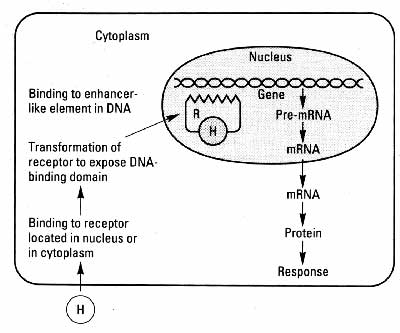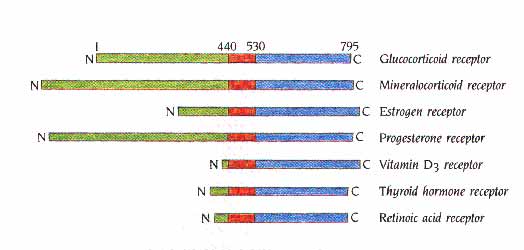Let me tell you...


Figure 1: Expression pathway
Figure 2: Conserved domains
| What are steroid receptors?
Let me tell you... |
|
| Steroid receptors are transcription factors that are used in a variety of pathways (Figure 1). There are several members of this family of receptors including the thyroid hormone receptor, the vitamin D3 receptor and the glucocorticoid receptor (GR) that will be discussed in detail in this site. All these receptors have a highly conserved DNA binding domain, C-terminal ligand binding domain, and an N-terminal transcription activation domain (Figure 2). The DNA binding region in all of these receptors bind to specific hormone response elements. In the case of the GR, it binds to two palindromic half-sites that are 6 bases long known as the glucocorticoid response element (GRE). These half sites are separated by three non specific bases. Studies have shown that a mutation in the spacer sequence where an extra base was added only allowed one of the monomers to bind properly. This sequence specificity allows it to regulate many different gene expression paterns. Upon binding of a ligand (glucocorticoid) the GR binds to the GRE which can either activate or repress a gene depending the nature of the GRE and its location in the gene. In particular it has been shown that GR is responsible for the regulation of gene expression controled by transforming growth factor-ß (TGF-ß). Some of the genes that are regulated by TGF-ß include several extracellular matrix proteins like fibronectin. This is done by selectively binding to the activation domain of the activator protein Smad3. One important aspect of the steroid receptor family of proteins is their use of zinc atoms to stabilize their structure and aid them in folding properly. | |
 |
 |
|
Figure 1: Expression pathway
|
Figure 2: Conserved domains
|